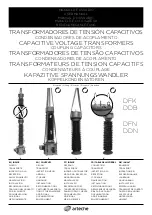
NX-203
12
3-3. Audio Amplifi er Circuit
Audio processing (high-pass filter, low-pass filter, de-
emphasized and so on) at FM mode and decoding at NXDN
mode are processed by DSP. The audio signal from IC108
and IC102 goes through the amplifier (IC704). The signal
then goes through a mute switch (IC707), amplifi er (IC713),
electronic volume control (IC703), and AF amplifi er (IC408).
While busy, AMT becomes Low to turn IC707 on, and
the signal is fed to the AF switch. While INAMT is High, the
AF switch (IC409) selects the internal speaker, and the au-
dio signal is fed to the internal audio power amplifi er (IC413),
and output to the internal speaker. While EXAMT is High,
the AF switch (IC409) selects the external speaker, and
the audio signal is fed to the external audio power ampli-
fi er (IC412), and output to the external speaker. The power
supply for IC413 and IC412 is turned on while INAMT or EX-
AMT is High.
The speaker is switched by the logic of the speaker
switching terminal SSW on the universal connector. When
the SP-MIC is not attached, SSW becomes High. IC108
detects the logic of SSW and activates either INAMT or EX-
AMT.
Q406
Q405
IC409
IC413
VDD
INT. SP
SHUT DOWN
B
INAMT
EXAMT
AF signal
from IC408
IC412
VDD
EXT. SP
SHUT DOWN
Fig. 3 Audio amplifi er circuit
3-4. Squelch Circuit
It amplifies the demodulated noise signal from IC108
after filtering through the BPF circuit. Then, the amplified
signal is converted to a DC signal by the detection circuit.
The converted signal is fed back to IC108.
DET
IC108
IC702
(1/2)
ASQAPC
ASQDET
LPF
IC711
(2/2)
HPF
Q704
AMP
D705
RECT
IC711
(1/2)
AMP
Fig. 4 Squelch circuit
4. Transmitter System
4-1. Audio Band Circuit
The signal from the internal microphone goes through
the mute switch (Q5). When the SP-MIC is not attached, the
microphone switching terminal (MSW) on the universal con-
nector becomes High, and the mute switch (Q5) is turned
on. When the SP-MIC is attached, MSW is connected to
GND inside the SP-MIC. For this reason, Q5 is turned off,
the internal microphone is muted, and only the input of the
external microphone is supplied to the microphone ampli-
fi er. The signal from the microphone goes through the mute
switch (Q707), and is amplifi ed by IC716 (1/2) and limited by
the AGC circuit which is composed of D703, D704, Q705
and Q706.
4-2. Base Band Circuit
The audio signal output from the base band circuit is con-
verted to digital data with a sampling frequency of 48kHz.
This digital data is sent to the DSP (IC102), and voice signals
of 300Hz or lower and frequencies of 3kHz or higher are cut
off and an audio range of 300Hz to 3kHz is extracted. The
audio signal is then pre-emphasized in FM mode and syn-
thesized with the signals, such as QT and DQT, as required,
and is then output from IC108. In Digital mode, the audio
signal is converted to the 4-Level FSK base band signal and
output from IC108. The DTMF and MSK base band signals
are also generated by the DSP and output by IC108.
LPF (IC705) works as a smoothing fi lter. The DAC (IC703)
assigns the base band signal to the VCO and VCTCXO (X1).
At this time, the level output according to the transmit car-
rier is fi ne-adjusted according to each modulation method.
SW
Q707
IC712
MM
AMP
IC710
(1/2)
LPF
IC706
LPF
IC705
(1/2)
AMP
IC703
IC710
(2/2)
IC108
ASIC
IC102
DSP
LPF
IC705
(2/2)
AMP
IC5
AMP
VCTCXO
X1
VCO
IC4
(1/2)
AMP
AGC
IC716
(1/2)
D703,D704
Q705,Q706
SW
Q5
Q4
SW
MSW
SCSW
INT. MIC
EXT. MIC
Fig. 5 Audio band and Base band circuit
CIRCUIT DESCRIPTION
Содержание NX-203
Страница 99: ...NX 203 99 MEMO ...
Страница 100: ...Printed in Japan No RQ076 Communications Systems Business Unit ...













































